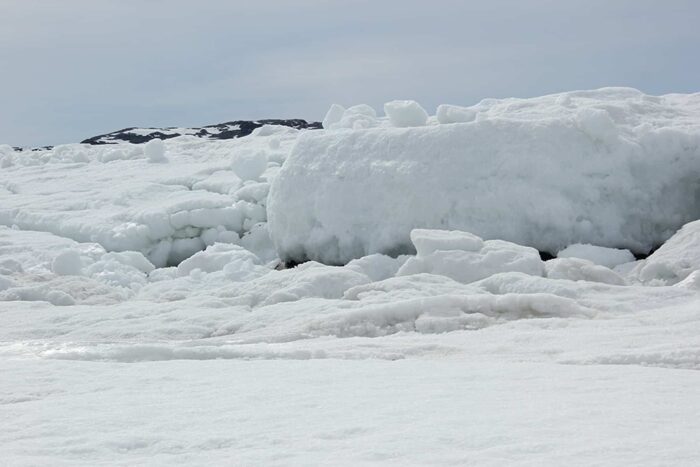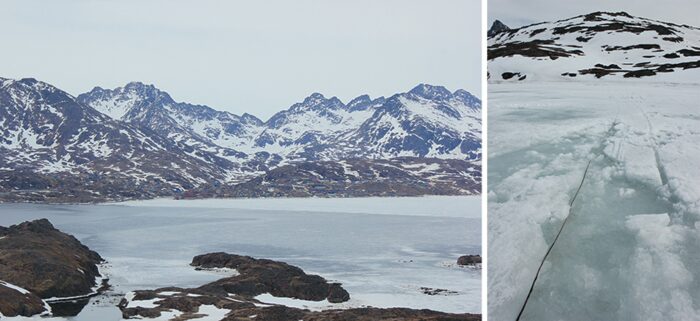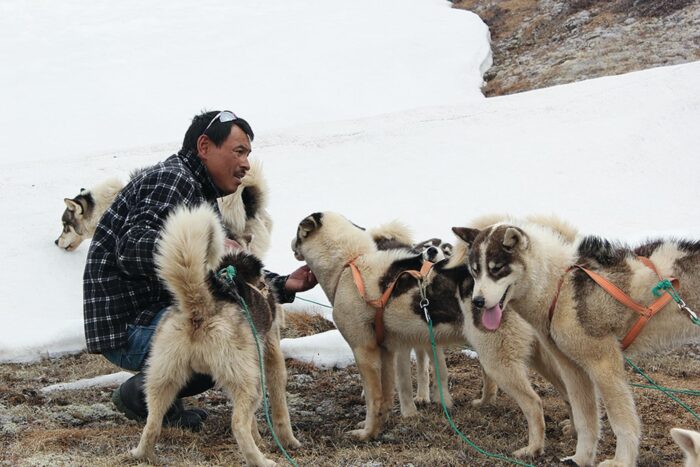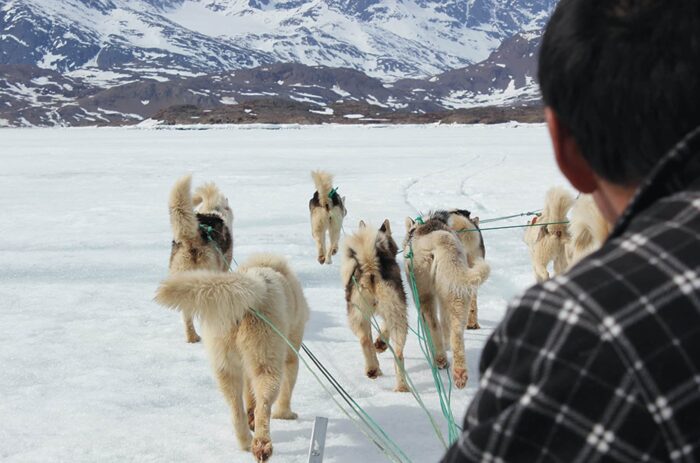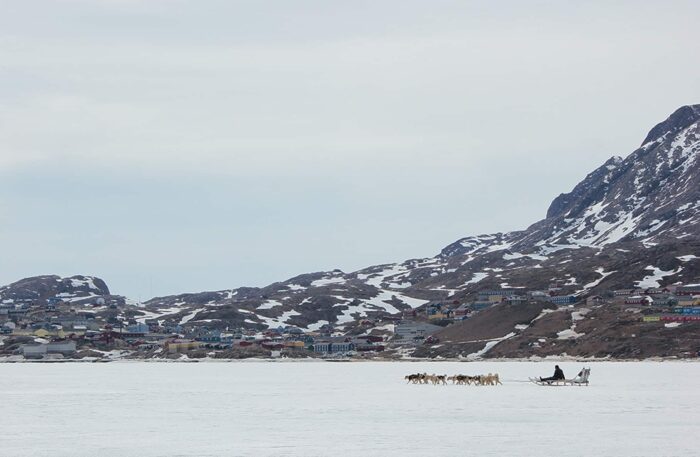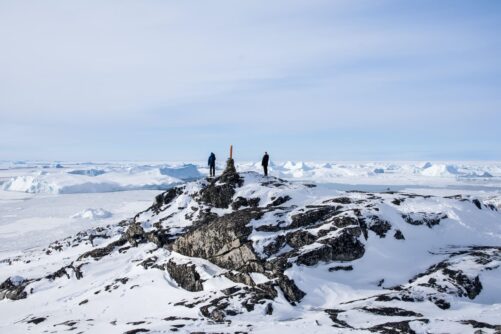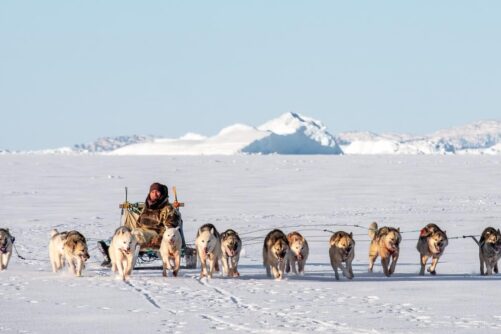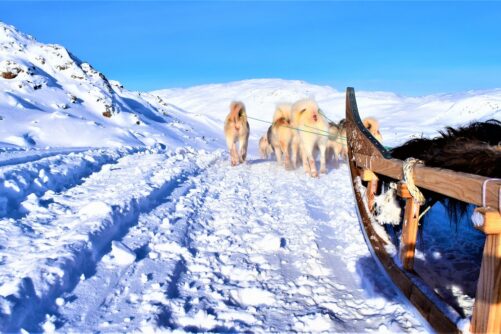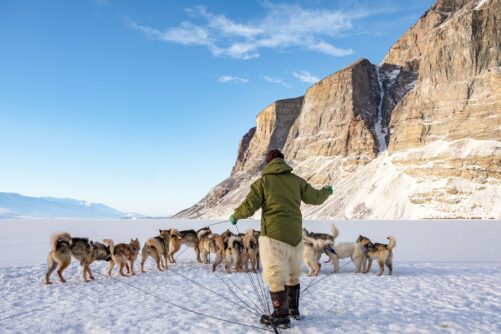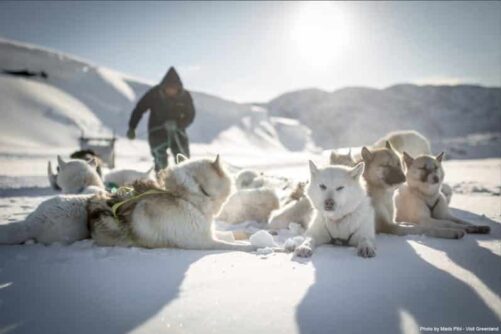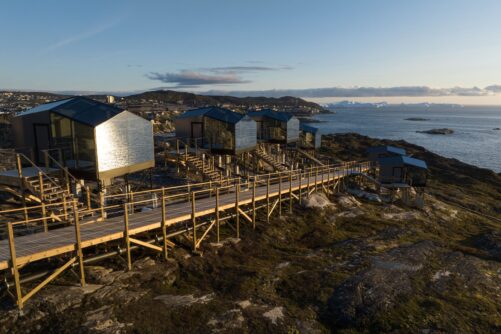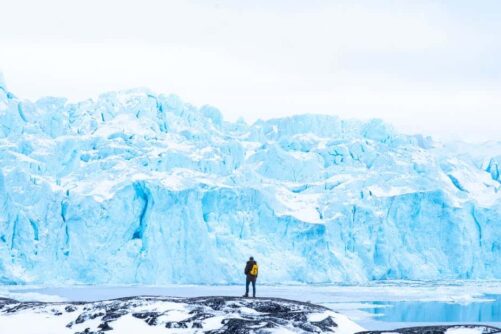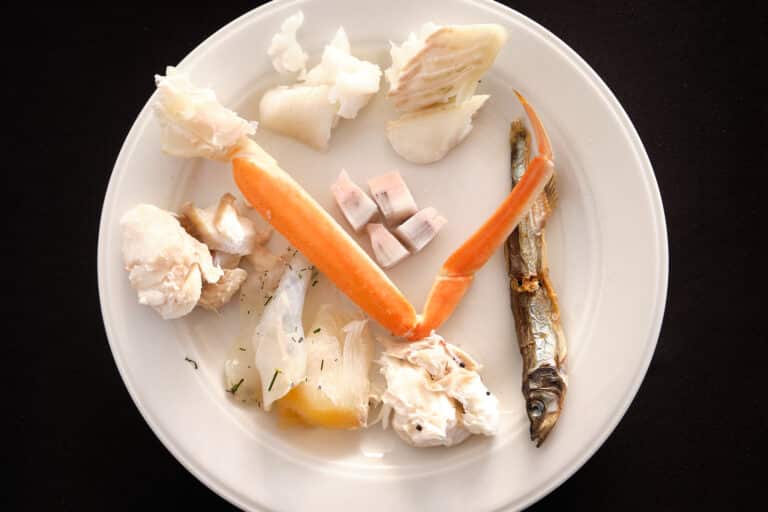

Dogsledding in East Greenland
Published: 22/07/2021
Reading time: 9 minutes
Nuka Utuaq has one of the best dog teams in Tasiilaq and he drives his sled every day in the winter season.
On Thin Ice in Tasiilaq
Nuka Utuaq is a busy man. When he isn’t hunting or fishing, he takes tourists out on his dog sled or works with handicrafts. He only hunts and fishes for personal use and says he is mostly an artist.
Tour over the Frozen Fjord
The fjord at Tasiilaq is frozen until May, when the ice begins to break up at the mouth of the fjord. Then open water gets closer to the town day by day and the first ship with supplies is expected to arrive by the start of June.
This year, the edge of the ice reached the town limits in the middle of May and since it is too dangerous to fish from the edge of the ice once the ice has broken up, holes have been made for fishing further in the fjord.
Tasiilaq Fjord in Spring
Every day, the ice gets thinner and more dangerous to be on.
The sun that beats down from early morning until past midnight helps to form kilometre-long cracks and small pools of meltwater on the fjord ice that – depending on size – freeze again at night.
In this way, there is not only one layer of ice on the fjord in the spring. At the bottom, there is the winter’s metre-thick ice. Laying over it is a growing layer of meltwater and on top of that, there is a thinner layer of new ice. This is the layer on which the fishermen walk, to get to their ice holes and on which the dog sleds drive, to get to the other side of the fjord where there is access to the hinterlands and onwards to e.g. the village of Tiniteqilaaq.
Ice Fishing in Tasiilaq
Every day, the ice is evaluated and discussed. By the middle of May, there are still eight ice fishing holes left and they are used a great deal both day and night.
No-one drives over the fjord on snowmobiles and most of the dog sled drivers have also stopped driving on the ice.
Dogsledding across the Ice
Nuka Utuaq has a good feeling for the ice and he has driven almost daily until now. He would not expose himself or his dogs to any danger and he only drives out on the ice with tourists as long as it is safe. As he picks up the day’s passengers on the way down to the ice, he says he doesn’t think it will be long, before he has to stop.
There is meltwater in between the pack-ice at the beginning of the ride out. In addition to being disturbingly wet, it is bumpy going for a while. The long sled only just reaches from ice floe to ice floe, but it still feels safe, although it is a rather exciting ride.
Breaking through the Ice
Further out, where the surface is more even to drive on and the sound of the ice is crisp and crackles, the dogs speed up. It is not the usual quiet creaking of the snow you get when you drive a dog sled in the winter, but a crackling sound from the newest ice crust that cannot yet bear the pressure. In several places, first one and then the other of the sled’s runners breaks through the ice and Nuka gives a loud whistle, making the dogs run as fast as they can.
They can’t really be bothered to run when it is warm, explains Nuka, although he is running hard in front. On a windless day like this, it is 11 degrees and it feels like a warm summer’s day because the sun is reflected by the shiny, wet surface of the ice.
On a Zigzag Course
Instinctively, the dogs sense whether the ice ahead is OK and they shift course constantly, so Nuka must keep making corrections with jo, jo, jo for left and drr, drr, drr for right. In addition, he talks constantly to the dogs in a praising and calming voice except when they suddenly split up and run on either side of a puddle of meltwater, so the sled runs through the middle. Then, there is more emphasis on corrections followed by a high whistle to keep up the pace when the sled runs over a kilometre-long fissure that fortunately seems to have frozen solid again.
When you look across the ice from the top of the mountain, you can clearly see the many blue areas with water, but when you drive on the ice, you don’t see the puddles until you are up close. Suddenly the dogs become nervous.
They lose speed and the lead dog looks back at Nuka, as if to ask for advice. Nuka reacts immediately when he discovers that there is open water to the right of the sled and with a series of loud »jo, jo, jo« shouts, he gets the sled turned further to the left. He stares for a long time at the water as the sled glides past. It was not here yesterday and now the ice is apparently melting faster.
The Last Dog Sledding Trip of the Season
This is going to be the last trip of the year, he determines, even before the sled has crossed the fjord to its destination in the fells on the other side and he has yet to make the trip back again.
There are no problems on the way up from the ice to the fells, although there is some pack-ice that must be scaled before the sled reaches land. On the other hand, there is not much snow left in the fells and in several places, the sled glides on bare earth and through mud.
Pølsi the Lead Husky
When the sled gets up into the fells, Nuka takes a break in an open spot with last summer’s withered heather. But the dogs find it is too warm and won’t lie down. They pull as far over towards one of the lovely, cold snow patches as possible before they calm down.
Now the sun is shining from an almost cloudless sky and Nuka takes off his jacket while he drinks the coffee he brought with him and sombrely looks back across the fjord with Tasiilaq on the other side. From up here, the growing areas with blue water can be seen clearly and Nuka plans to take another route back, in a wide arc nearer the head of the fjord, where the ice looks better and less wet.
Dog hierarchy
Some of the dogs roll around in the dry heather which is good for scratching backs. Others look as though they have fallen asleep as soon as they lie down.
The lead dog »Pølsi« walks between the dogs and marks his rank by receiving appreciative licks from them and they show their submissiveness by offering their throats while »Pølsi« sniffs them or simply haughtily ignores them. A couple will not bow down and their ears flatten, but there is no fighting, because a little snarl from »Pølsi«, with a small show of teeth, gets them to lie down. At the same time, Nuka says a few words in a reproachful tone, mentioning the »rebellious« dogs by name. Then he goes and pats »Pølsi« first to maintain the hierarchy, then the neediest dogs. Especially the two youngest, which are only eight months old, need some attention, but so does »One Eye« who is different because he has one brown eye and one blue eye.
»Pølsi«, who has reacted to the mention of his name and is standing up, gets some more pats and cuddles. It is clear that there is a feeling of mutual respect and love between the dog and Nuka. This trust has been built up after many hours of sledding for several winters.
Nuka is entirely dependent upon the skills and obedience of his dogs when they are out together and this has just been demonstrated on the zigzag ride across the fjord.
A workplace
Extra harnesses and a rope hang on the sled. At the back, there is a brake that is down while the dogs are being harnessed so they don’t start to pull, because they are always very eager to set off. There is also an ice probe – »Ajaappiar« in East Greenlandic and a whip – »Noqqardaa«.
Nuka demonstrates how the whip is used and he cracks the whip again and again with easy movements of his hand. For him, the whip is an essential precision tool and he does not touch the dogs with the whip. He only lets it crack next to the ears of a dog that is about to head in the wrong direction.
He rarely uses it and only in places where it is necessary to drive very carefully, such as between the holes in the fjord ice.
Heavy lifts
Depending on conditions, the dogs can pull between 500 and 1000 kilos as well as Nuka himself. However, there is rarely the need for them to pull so much.
Last trip
The run down to the fjord is taken at full speed across the remaining snow and, in some places, the bare ground. In the beginning, the new route seems to be better, but further out on the ice, both the dog and Nuka become wary. In the end, Nuka stops and climbs off the sled with his »Ajaappiar« to test the ice. He immediately goes through the first layer, but luckily there is not very much water on top of the old ice underneath. Then, the ice creaks and rumbles dangerously and Nuka tells the dogs to set off and throws himself onto the sled that also goes through the ice. It’s a good thing he has such good control over the dogs and that they are so strong. In a few vital seconds, they pull the sled away from the hole and Nuka sits still for a long time, keenly observing the area in front of the sled. Little by little, he relaxes, again enjoying the present, while the sled travels home at full speed to Tasiilaq.
– Today’s trip will be the last one of the year, he announces thoughtfully – but with a big smile.
Find dogsledding trips in Greenland here! Or read the Ultimate Guide to Tasiilaq!
Read more travel blogs from Mads Nordlund
-

Dogsledding – 4 hours | Uummannaq | North Greenland
Tour startsUummannaqDuration4 hoursFrom 4200 DKKSee more -
4.80(10)

Dogsled tour | Ilulissat | Disko bay
Tour startsIlulissatDuration2 hoursFrom 1695 DKKSee more -
5.00(2)

The Ultimate 8-day Arctic Winter Adventure | Ilulissat | Disko Bay
Tour startsIlulissatDuration8 daysFrom 17700 DKKSee more -
Flights included!

Holidays at the Ice Sheet | 6 days | Kangerlussuaq | West Greenland
Tour startsFrom CopenhagenDuration6 daysFrom 15700 DKKSee more -
Authentic experience!

Expedition on Dogsled | 2 Days | Ilulissat
Tour startsIlulissatDuration2 daysFrom 10700 DKKSee more -
Including flights from Iceland

Tasiilaq Winter World | 8 Days | East Greenland
Tour startsTasiilaqDuration8 daysFrom 29650 DKKSee more -

Settlement Tour By Dogsled | Tasiilaq | East Greenland
Tour startsTasiilaqDuration2 daysFrom 2700 DKKSee more -
New tour

Dog sledding tour to the UFO cabin | Sisimiut
Tour startsSisimiutDuration4 hoursFrom 2100 DKKSee more -

Dog Sled Expedition | Tasiilaq | East Greenland
Tour startsTasiilaqDuration5 hoursFrom 1700 DKKSee more -

Dogsledding – 2 hours | Uummannaq | North Greenland
Tour startsUummannaqDuration2 hoursFrom 2400 DKKSee more -
5.00(1)

4 hours Dogsledding tour| Ilulissat | Disko Bay
Tour startsIlulissatDuration4 hoursFrom 2595 DKKSee more -
Group pricing

Two-Day Dog Sled Adventure | Kangerlussuaq
Tour startsKangerlussuaqDuration2 daysFrom 9800 DKKSee more -

4 hour Dog Sledding Tour | Kangerlussuaq | West Greenland
Tour startsKangerlussuaqDuration5 hoursFrom 2725 DKKSee more -
FLIGHTS FROM DENMARK INCLUDED!

Luxury Arctic Escape – Aurora Cabins & Helicopter Glacier Tour | 5-Days | Ilulissat
Tour startsFrom CopenhagenDuration5 daysFrom 30300 DKKSee more -
5.00(3)

Dog sledding expedition | Kangerlussuaq to Sisimiut | West Greenland
Tour startsKangerlussuaqDuration3 daysFrom 17800 DKKSee more -

Best of winter in Greenland | 5 Days in Sisimiut, West Greenland
Tour startsSisimiutDuration5 daysFrom 9300 DKKSee more -
5.00(2)

Dog Sledding Tour | Kangerlussuaq | West Greenland
Tour startsKangerlussuaqDuration2 hoursFrom 1895 DKKSee more -
4.00(1)Accommodation & tours included!

Highlights of the Arctic winter in 5 days | Ilulissat | Disko Bay
Tour startsIlulissatDuration5 daysFrom 11700 DKKSee more


